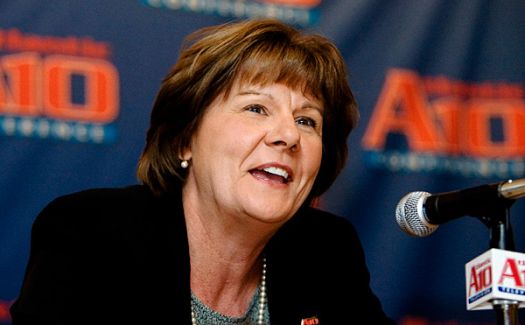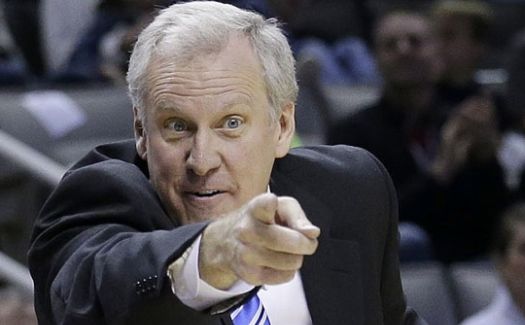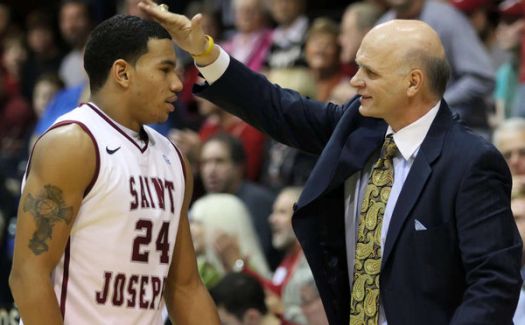2013-14 RTC Conference Preview: the Atlantic 10
Posted by Joe Dzuback on November 5th, 2013Joe Dzuback of Villanova by the Numbers is the RTC correspondent for the Atlantic 10. You can find him on Twitter at @vbtn.
Top Storylines
- Conference Realignment, Round Two – When back in March 2012, Temple — followed quickly by Charlotte — announced their intent to leave the conference at the end of the 2012-13 season, Atlantic 10 commissioner Bernadette McGlade had nearly 15 months to deliver their replacements. The former ACC Associate Commissioner took less than eight weeks to ink two stellar programs (VCU and Butler) that could potentially eclipse the departing teams. Through an accident of timing, the conference drew five NCAA bids from its 16 teams, matching their previous bid highs of 1996-97 and 1997-98. The A-10’s second brush with Realignment Fever (Butler and Xavier to the Big East, effective June 30, 2013) handed McGlade a far smaller window to audition replacements. Her second attempt at matchmaking yielded George Mason and Davidson, two solid additions that fall short of her first effort. That headliners Temple, Xavier and Butler (Johnny, We Hardly Knew Ye) departed together, with Davidson not due to join until 2014-15, leaves the conference with less name recognition than it has had since the early 1990s.
- The “It” Place – Inking a five-year deal with the Barclays Center to host the Atlantic 10 Tournament seemed prudent at the time. The shovels had barely turned the dirt on Atlantic Avenue in Brooklyn and the conference was in the early stages of negotiations for television coverage. McGlade’s gamble paid dividends as the 2013 conference tournament offered the strongest field in a decade in one of the year’s hottest new basketball venues. Couple the exposure from basketball (the Brooklyn Nets, the A-10 Tournament, several in season double- and triple-headers) and music, and suddenly the Barclays Center has become one of the most popular entertainment venues in New York City. For the A-10, the challenge will be to develop comparable gate numbers to those of the venue’s higher profile entertainment offerings.
Predicted Order of Finish
Rankings from the conference coaches’ Media Day Poll are in square brackets to the right of the projected conference record.
- Virginia Commonwealth (13-3) [#1]
- Saint Louis (12-4) [#2]
- La Salle (12-4) [#3]
- Massachusetts (11-5) [#4]
- George Washington (10-6) [#10]
- Richmond (9-7) [#6]
- George Mason (9-7) [#8]
- Dayton (7-9) [$7]
- Rhode Island (7-9) [#9]
- St. Joseph’s (6-10) [#5]
- Fordham (4-12) [#11]
- St. Bonaventure (3-13) [#12]
- Duquesne (1-15) [#13]
All-Conference Impact Team
The conference coaches have spoken on the all-conference teams, and frankly I cannot argue with their choices. Transfers and JuCos have become a fact of life as the “new” Division I has become “waiver friendly.” Who among the newbies suiting up this season can make a difference for their team?
- G: DeShon “Biggie” Minnis, Rhode Island (Texas Tech) – Will compete for a starting job at the point, Minnis is quick enough to disrupt the defense. If he gets his passing in order will be able to set up teammates.
- G: Derrick Gordon, Massachusetts (Western Kentucky) – Earned a spot on the Sun Belt-All Conference Third Team as a freshman. Gordon scored 412 points and snagged 236 rebounds from the Hilltopper back court.
- G: Jordan Sibert, Dayton (Ohio State) – The guard will compete with Vee Sanford for minutes at the off guard spot, but if his shot comes around he will give the Flyers a sorely needed scoring threat.
- F: Gilvydas Biruta, Rhode Island (Rutgers) – Solidly built and very coachable, Biruta, a virtual unknown as a freshman in the Big East in 2011-12 turned quite a few heads his first season. He will do the same for his high school coach, Danny Hurley.
- F: Ovie Soko, Duquesne (UAB) – Started 56 games in three seasons at UAB. Can score around the basket and should provide Dukes with a low post presence they have lacked the past three seasons.
Predicted Champion
- Virginia Commonwealth (NCAA, Seed #4) – Shaka Smart returns 63% of the minutes, 70% of the points scored and 72% of the rebounds from the team that played Saint Louis for the conference championship in Brooklyn, secured a #5 seed to the NCAA and fell to national runner-up Michigan in the third round. Assists (the Rams return only 51% of those from last year – the influence of David Theus and Troy Daniels) represent the largest gap this season’s squad will have to span. If Smart opts for an extra forward, expect Florida State transfer Terrence Shannon (6’5”, 240 lbs), a fifth year senior, to get the nod. Senior Rob Brandenberg and junior Briante Webber will then have to replace Theus’ assists. Webber, a recognized defensive specialist, will have to go longer than the 20 or so minutes he logged per game last season. Smart has a pool of three redshirt and five true freshmen from which he can fashion a rotation.
Other Postseason Teams
When the conference collected five NCAA bids it tied its all-time high (matched twice) set in the late 1990s. Five bids are extremely unlikely this season, but four, a number that has become almost foregone in seasons past, is very possible. The conference has four strong candidates in VCU, St. Louis, La Salle and Massachusetts, and typically sends half of league members to a postseason tournament.
- Saint Louis (NCAA, Seed #5) – The Billikens will put a senior-laden team on the court this season. Though they return 68% of their minutes and points, the overwhelming proportion of those numbers are from seniors this season. Whether this squad can repeat as conference champions (regular season and tournament champions) will depend on who steps into the departed Kwamain Mitchell’s role. Mitchell did not excel in any particular category but he, along with the also departed Cody Ellis and Cory Remekun, provided a steady hand when VCU’s Havoc Defense wrought, well havoc, in the second half of the championship game. Someone else will have to step up this time around. Jim Crews has shown he can coach an experienced group of talented players, but this season Saint Louis fans will see the fruits of his recruiting (both freshmen and transfer). Freshmen forward Reggie Agbeko and guard Mike Crawford will work themselves into the rotation.
- La Salle (NCAA, Seed #10) – Those looking for a dark horse in the A-10 race should look to Dr. John Giannini’s Explorer program. It took 10 years, but few outside of Philadelphia have any idea how massive this rebuilding project has been. The Explorers return 83% of the minutes, 76% of the points and 83% of the rebounds from the squad that drew a #12 seed and ran to the Sweet Sixteen last March. November and December seemed to preview another almost-but-not-quite season for La Salle, but Tyronne Garland became eligible and the team motor found another gear. Garland did not garner a lot of postseason recognition (at least not before the last-minute floater that knocked Ole Miss out of the tournament), but if he progresses this season, he should. Giannini plays an uptempo three guard offense that relies on quickness and uber-athletic forward play to collect defensive rebounds and close passing lanes that can confuse and force turnovers. Giannini varies that quick lineup with one that will feature junior center Steve Zack whose 6’11” frame is filled out to the tune of 245 pounds. Zack, not available for the NCAA, can provide that traditional offensive and defensive face that confounds offenses when alternated with the smaller, quicker lineup.
- Massachusetts (NCAA Seed #12) – The Minutemen had, despite three chances, no signature wins to cushion them when they hit that mini-slump in February. Derek Kellogg’s squad logged 21 wins and a 9-7 conference record going into Selection Sunday, but their #138 ranked non-conference strength of schedule impressed no one. Kellogg got the hint and upgraded UMass’ schedule this time around. The Minutemen added five power conference teams to their traditional rivalry (Providence, Big East) and mid-major standout Elon (Southern Conference). Kellogg has a solid backcourt with senior Chaz Williams returning for one last season, to be paired with either transfer Derrick Gordon (Western Kentucky) and/or sophomore Trey Davis, who played behind the departed Freddie Riley. The frontcourt has experience as seniors Sampson Carter and Raphiael Putney will work out the starting lineup and rotation with juniors Cady Lalane and Maxie Esho (and possibly sophomore Tyler Bergantino and three freshmen, redshirt Clyde Santee, Seth Berger and Zach Coleman). The key will be drama. Promising starts in 2011-12 and 2012-13 were sabotaged by misbehaving players whose suspensions (and dismissals) disrupted the starting lineup and no doubt the focus.
- George Washington (NIT, Seed #4) – The Colonials return 72% of their minutes, 68% of their points, 75% of their rebounds and all five starters from the freshman-heavy squad that went 7-9 in conference play last season. The nucleus is now a mix of seniors and sophomores, as the last vestiges of the Karl Hobbs program left. Fifth year senior Maurice Creek from Indiana will balance another youth push on the recruiting front. Coach Mike Lonergan brings in three more freshman, the most promising of which is guard Nick Griffen, who will join Kethan Savage, Joe McDonald and Creek in a backcourt rotation. How quickly the freshmen can contribute will determine where the Colonials finish in the standings.
- George Mason (NIT/CBI) – Coach Paul Hewitt’s strong suit was always recruiting, his entering classes at Georgia Tech were routinely rated in the top 10 annually and he has recruited well for the Patriots in his two years at the Fairfax, Virginia school. Hewitt will have to step up his recruiting yet again as the Patriots move up to the A10 from the CAA. Hewitt returns five starters on a senior-laden squad. The Patriots return 84% of the minutes, 87% of the points and 86% of the rebounds. Sherrod Wright should find his way onto a number of All-Conference First Team ballots by season’s end and Hewitt’s squad should end up north of 0.500 in conference play, the schedule makers handed GMU George Washington, Massachusetts, St. Louis and Duquesne as the Patriots’ home-away opponents (they should go no worse than 3-5, maybe 4-4 or 5-3), and home games with potential rivals Saint Joseph’s, Dayton and Richmond (3-0?) and finally road games with Fordham and Rhode Island (2-0? 1-1?). Then throw in the Bonnies at home February 15.
- Richmond (NIT/CBI) – Despite losing two starters (Greg Robbins and Darien Brothers) the Spiders return 85% of their minutes, 79% of the points (here is the problem) and 90% of the rebounding from last season’s 19-15 (8-8 in conference) team. Coach Chris Mooney developed a virtual 10-man rotation that saw eight players earn time in all 34 Richmond games last season, and two more appear in 32 and 25 respectively (Derrick Williams missed the month of January with injuries). Mooney brings in four more freshmen (no transfers/JuCos, his system works best when manned by four year players), three guards and a wing. Mooney will have to replace the 700 points Brothers and Robbins contributed, but Kendall Anthony will most likely start, with Trey Davis (sophomore wing) and Wayne Sparrow (junior off guard) will get their chance. Williams has to stay healthy, the Spiders were 9-5 when Williams tore his ankle ligaments, then logged 5-4 in the big man’s absence (14-9), and limped (literally, 5-6) with Williams still gimpy.
The Rest
- Dayton – The Flyers return three of their five starters from last season, but count it as four as Matt Kavanaugh, suspended on the eve of fall practice last season, is back. Coach Archie Miller needed Kavanaugh last season as then freshman Jalen Robinson struggled in the low post. Backcourt mates Khari Price and Vee Sanford will be joined by freshman Scoochie Smith and transfer (Ohio State) Jordan Sibert. The frontcourt is in better shape with Kavanaugh back, Robinson a year older, Dyshawn Pierre and Devin Smith growing more comfortable with their roles in Miller’s system. The collective will need to make up for the 800+ points scored by the departed Kevin Dillard and Josh Benson. That’s a tall order.
- Rhode Island – Rhode Island was left for dead when Wagner coach Danny Hurley took the reins in 2012-13. Hurley recruited Xavier Mumford who played immediately and helped the Rams win three games in conference play and eight overall. Hurley found players with potential in Jordan Hare, Mike Aaman and Mike Powell. He also collected three transfers, Gilvydas Biruta (Rutgers), Jarelle Reischel (Rice) and DeShon “Biggie” Minnis (Texas Tech) who should make an impact in Rhodi’s conference presence. Biruta, a refuge from the Mike Rice regime at Rutgers is an old school “no blood, no foul” Big East front court player who should give a tougher presence in the low post and lane. Hurley brought in three well-regarded freshmen in E.C. Matthews, a consensus top 75 recruit, Hasan Martin and Matthew Butler. Hurley’s club will improve their record this season, but should make a bigger move in 2014-15.
- Saint Joseph’s – The consensus #1 pick last season fell hard. If the team this season is to finish higher than #10 (that is where I have them, going against the consensus #5 pick by the conference coaches), they will have to benefit from addition by subtraction. Carl Jones and C.J. Aiken have departed. What is left (three starters and several rotation players) is good, but Chris Wilson will have to grow into the point guard job and one of the freshmen (or redshirts) will have to surprise (DeAndre Bembry is my hedge here) to move the Hawks back into the upper half of the conference.
- Fordham – Coach Tom Pecora welcomes New York City’s player of the year, Jon Severe, to Rose Hill. Severe joins a good backcourt that features Branden Frazier, Jermaine Myers, Bryan Smith and Mandell Thomas. Severe can make this a very good back court, while a JuCo, Chris Whitehead may log a few minutes at the point. The Rams have a good back court with the potential to be better. Ryan Rhoomes, Ryan Canty and Travion Leonard will form the front court nucleus, with time available for freshmen Manny Suarez. Note the freshmen and transfers? They represent an upgrade over the talent (Chris Gaston excepted) Pecora found when he arrived in 2010-11, but they will have to produce quickly to make a difference this season.
- St. Bonaventure – The Bonnies are two years into the post Andrew Sullivan Era, and Coach Mark Schmidt’s inability to recruit to Western New York is depressing. Returning players Matthew Wright, Charlon Kloof and Jordan Gathers form a serviceable backcourt, while returners Youssou Ndoye, Marquis Simmons and Dion Wright will fashion a front court rotation. Look for Schmidt’s two JuCos and three freshmen to draw minutes.
- Duquesne – Coach Jim Ferry was new, but the off season was depressingly familiar – another roster overhaul triggered by outbound transfers. Promising point guard Derrick Colter will play a second season with senior Jerry Jones and sophomore Jeremiah Jones. Transfers Ovie Soko (UAB of the C-USA) along with JuCos Tra’Vaughn White and Dominique McKoy (yes, late of URI via Cowley Community College) form the nucleus. Ferry also brought in five freshmen.
Final Thoughts
With three or four participants annually, the Atlantic 10 has become a consistent contributor to the NCAA field. Those concerned the conference will struggle with the departure of three outstanding programs, two of which have been flagship programs for the past decade, should recall that Butler’s tenure (one season) was too small for the Bulldogs to realistically affect the conference’s reputation. Xavier, a flagship program along with Temple, has not been to the NCAA in two seasons (and will most likely miss again). Temple, one of the winningest programs in NCAA history, will be missed, but as the third member located in Philadelphia, the Owls may have contributed to the conference’s “Philadelphia-centric” reputation. The A-10 will be fine, and on Selection Sunday next March, it says here that four teams should hear their name called.












































